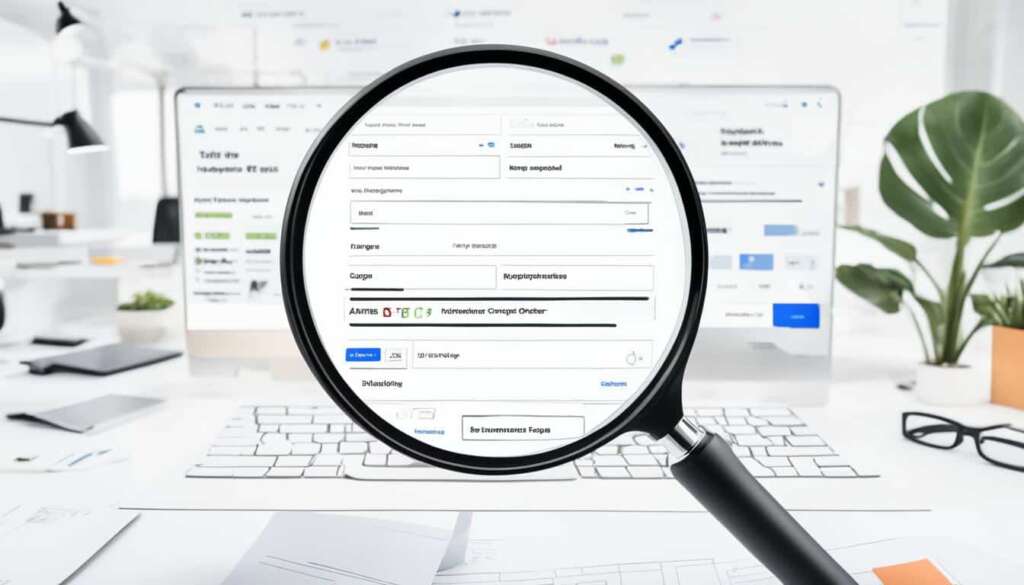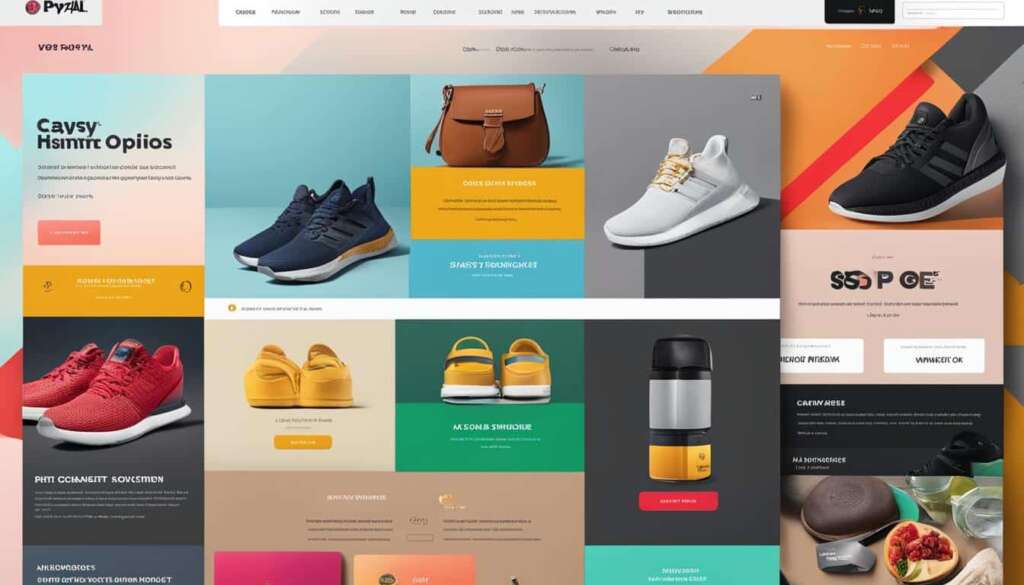Table of Contents
Optimizing your online store is crucial in today’s competitive e-commerce market. As more and more businesses move towards online platforms, standing out and capturing visitors’ attention has become paramount to success. One of the key elements of optimization is focusing on your store’s homepage. By implementing effective web design strategies, you can optimize your online store and improve its performance, leading to increased traffic, better search engine rankings, higher conversions, and ultimately, more sales.
When it comes to homepage optimization, web design plays a crucial role. It is the first impression visitors have of your online store, and it can make or break their decision to explore further. By incorporating best practices such as intuitive navigation, visually appealing layouts, and compelling copy, you can create a homepage that captures attention and encourages visitors to stay and explore your offerings.
Additionally, optimizing your online store’s homepage includes various technical aspects. It involves ensuring fast loading times, mobile responsiveness, and search engine-friendly elements such as title tags, meta descriptions, and image optimization. By paying attention to these details, you can enhance the user experience, improve your website’s visibility in search engine results, and attract more potential customers to your online store.
In the upcoming sections, we will delve deeper into specific strategies to optimize your e-commerce homepage. We will explore the importance of an effective SEO strategy, the role of compelling calls-to-action, the significance of mobile optimization, and finally, the importance of continuously testing and refining your approach. By implementing these strategies, you can create a homepage that not only captures attention but also converts visitors into loyal customers.
Employ an SEO homepage strategy
A strong SEO homepage strategy is essential for driving organic traffic to your website. To create an optimized homepage that attracts visitors and boosts your search engine rankings, follow these key steps:
1. Optimize Above-the-Fold Content
The content that appears above the fold is what visitors see first when they land on your homepage. It’s crucial to make a positive first impression and provide relevant information. Ensure that your above-the-fold content includes:
- Your branding and logo to create a visual identity for your website
- Contact information to make it easy for visitors to get in touch with you
- A clear navigation and search bar for easy website exploration
- Current promotions and offers to entice visitors to make a purchase
- A shopping cart to allow visitors to add items and proceed to checkout
- Calls-to-action strategically placed to encourage visitors to take specific actions (e.g., “Buy Now,” “Sign Up,” “Learn More”)
2. Optimize Title Tags and Meta Descriptions
Optimizing your homepage’s title tags and meta descriptions helps search engines understand the content and purpose of your website. Include relevant keywords in your title tag and write a compelling meta description that entices users to click on your website in the search results.
Example: Title Tag – “Shop the Latest Fashion Trends | Your Fashion Store”
Example: Meta Description – “Discover the hottest fashion trends at Your Fashion Store. Shop our wide selection of clothing, footwear, and accessories. Enjoy free shipping on all orders!”
3. Optimize Images
Optimizing your website’s images is important for both user experience and SEO. Resize your images to improve page loading speed and add relevant ALT text and captions to optimize them for search engines. ALT text should accurately describe the image and include keywords related to your homepage content.
4. Continuously Refine Your Strategy
Homepage optimization is an ongoing process. Regularly monitor your website’s performance, analyze user behavior, and make data-driven adjustments. Conduct A/B testing to experiment with different elements and determine what works best for your target audience.
By employing an effective SEO homepage strategy, you can enhance your website’s visibility, attract more organic traffic, and ultimately increase conversions and sales.
Use Effective Calls-to-Action
Calls-to-action (CTAs) are essential elements in encouraging website visitors to take specific actions and increasing conversions. By experimenting with different types of CTAs, conducting A/B testing, and optimizing the CTA button color, placement, and wording, you can create CTAs that resonate with your target audience and drive desired actions. Here are some strategies to consider:
1. Explore Different CTAs
Experiment with various CTAs to determine which ones work best for your target audience. Consider using compelling phrases such as “Schedule a Demo,” “Begin Free Trial,” or “Buy Now” to prompt visitors to take action. Tailor your CTAs to align with your products or services and the specific goals of your website.
2. Conduct A/B Testing
A/B testing is a valuable technique to assess the effectiveness of different CTAs. Split your audience into segments and test variations of CTAs, such as different button colors, placement, or wording. By analyzing the data and measuring conversion rates, you can identify the most successful CTA strategies and refine your approach accordingly.
3. Optimize CTA Button Color
The color of your CTA buttons can significantly impact their visibility and click-through rates. Use contrasting colors that stand out from the rest of your website design to capture visitors’ attention. For example, a bright orange CTA button on a predominantly blue and white website can create an eye-catching contrast that draws the user’s focus.
4. Consider CTA Placement
The location of your CTAs can also influence their effectiveness. Placing CTAs above-the-fold ensures they are immediately visible to visitors without scrolling. This prime positioning increases the chances of attracting attention and prompting action. Experiment with different CTA placements, such as near headline texts or at the end of product descriptions, to find the most effective locations for your specific website.
“By using compelling CTAs, conducting A/B testing, and strategically optimizing the color and placement of your CTA buttons, you can guide visitors towards taking desired actions and maximize your conversion rates.”
Remember, there is no one-size-fits-all approach when it comes to CTAs. What works for one website may not necessarily work for another. To optimize your CTAs effectively, continuously monitor their performance, analyze visitor behavior, and make data-driven adjustments to improve conversion rates and drive desired actions.
| Best Practices for CTA Optimization |
|---|
| Use action-oriented language that conveys a sense of urgency. |
| Keep CTAs concise and clear, avoiding excessive text. |
| Create a sense of trust and credibility by including trust indicators, such as customer testimonials or security badges, near your CTAs. |
| Use visually appealing and attention-grabbing designs for your CTA buttons. |
| Regularly test your CTAs and make data-driven optimizations based on the insights gained. |

Optimize for Mobile Devices
In today’s mobile-driven world, it is crucial for e-commerce businesses to prioritize mobile optimization to provide a seamless experience for mobile users. By optimizing your website for mobile, you can ensure that visitors can easily browse, interact, and make purchases using their smartphones or tablets.
One of the key aspects of mobile optimization is implementing a responsive design. A responsive design involves creating a website that adapts and adjusts its layout, content, and functionality based on the screen size and resolution of the device being used. This ensures that your website looks and functions optimally on all mobile devices, regardless of their screen size.
A hamburger menu is a popular design element for mobile optimization. The hamburger menu, typically represented by three horizontal lines, eliminates clutter on smaller screens by hiding the navigation menu behind an icon. When users tap on the hamburger menu icon, the menu expands, allowing them to access various pages and sections of your website.
Another crucial element of optimizing the mobile user experience is using large, tappable CTA buttons. Since mobile screens are smaller, it is essential to make your call-to-action buttons prominent and easily clickable. This ensures that users can easily take the desired action, whether it’s making a purchase, signing up for a newsletter, or contacting customer support.
To further enhance the mobile user experience, A/B testing for mobile is fundamental. A/B testing involves creating different versions of your mobile website or app and analyzing user behavior to determine which version performs better. By conducting A/B tests, you can gain insights into user preferences, identify areas for improvement, and make data-driven decisions to optimize individual elements of your mobile site or app.
Benefits of Mobile Optimization
Mobile optimization offers several benefits for e-commerce businesses:
- Improved user experience: Mobile optimization ensures that your website is user-friendly, easily navigable, and visually appealing on mobile devices, creating a positive user experience.
- Increased conversion rates: By optimizing the mobile user experience, you can minimize friction and make it easier for users to complete their desired actions, resulting in higher conversion rates.
- Better search engine rankings: Search engines prioritize mobile-friendly websites in their search results, so optimizing for mobile can improve your website’s visibility and organic rankings.
- Expanded customer reach: As mobile usage continues to increase, optimizing for mobile allows you to reach a wider audience and tap into the growing number of mobile shoppers.
By prioritizing mobile optimization, implementing a responsive design, enhancing the mobile user experience with a hamburger menu and large CTA buttons, and conducting A/B testing for mobile, e-commerce businesses can maximize their potential for success in the mobile era.
Conclusion
Optimizing your e-commerce website’s homepage is a critical step towards driving sales and enhancing user experience. By employing an SEO strategy, using effective calls-to-action, optimizing for mobile devices, and continuously testing and refining your approach, you can create a homepage that captures attention and converts visitors into customers.
It is essential to stay up-to-date with the latest trends in web design and continually optimize your website to stay ahead of the competition in the ever-evolving e-commerce landscape. By keeping a close eye on your analytics, conducting A/B testing, and analyzing user behavior, you can uncover opportunities for improvement and make data-driven decisions to maximize your homepage’s performance.
Remember that your homepage is often the first impression visitors have of your online store, and it plays a crucial role in establishing trust and credibility. Ensure that your branding and messaging are consistent, and your design is visually appealing and user-friendly across all devices.
By prioritizing homepage optimization, you can create a compelling online shopping experience that not only attracts potential customers but also guides them seamlessly along the conversion path. Invest time and effort in optimizing your homepage, and you’ll reap the rewards of increased sales and satisfied customers.
FAQ
Why is optimizing my website for e-commerce important?
Optimizing your website for e-commerce is crucial in today’s competitive market. The shift towards online shopping has accelerated due to the pandemic, and businesses need to stand out and capture visitors’ attention right from the homepage. A well-optimized homepage can make a significant impact on website traffic, search engine rankings, conversions, and ultimately, sales numbers.
What should I include in my homepage’s above-the-fold content?
Start by including branding and logo, contact information, navigation and search bar, current promotions, shopping cart, and calls-to-action. This content is what visitors see first, so it’s essential to make a strong impression and guide them through the website effectively.
How can I optimize my homepage’s title tag and meta description?
To optimize your homepage’s title tag and meta description, include relevant keywords and compelling language that accurately represent your business and offerings. This helps search engines understand the content of your page and entices users to click through to your website when they see it in search results.
How can I optimize images on my homepage?
To optimize images on your homepage, resize them to the appropriate dimensions and compress them without sacrificing quality. Additionally, add ALT text and captions to provide context and improve accessibility for both users and search engines.
How can I create effective calls-to-action (CTAs) on my homepage?
Experiment with different types of CTAs, such as “Schedule a Demo,” “Begin Free Trial,” or “Buy Now,” to see which ones resonate best with your target audience. A/B testing can help you determine the most effective CTA button color, placement, and wording. For example, using a contrasting color and placing the CTA above-the-fold can capture visitors’ attention and prompt them to take action.
Why is it important to optimize my website for mobile?
As more shoppers use mobile devices to browse and purchase products, it is essential to prioritize the mobile experience. By optimizing your website for mobile, ensuring it is responsive and easy to navigate on smaller screens, you can cater to a large and growing segment of customers and improve their overall satisfaction and conversion rates.
How can I optimize my website for mobile?
Optimize your website for mobile by using responsive design techniques that adapt the layout and content to different screen sizes. Implement a hamburger menu for easy navigation on mobile and use large, tappable CTA buttons for a better user experience. A/B testing is crucial for mobile optimization, as customers may use mobile as a touchpoint in their shopping journey. Understanding how your customers use mobile will help you test and optimize individual elements of your mobile site or app.













